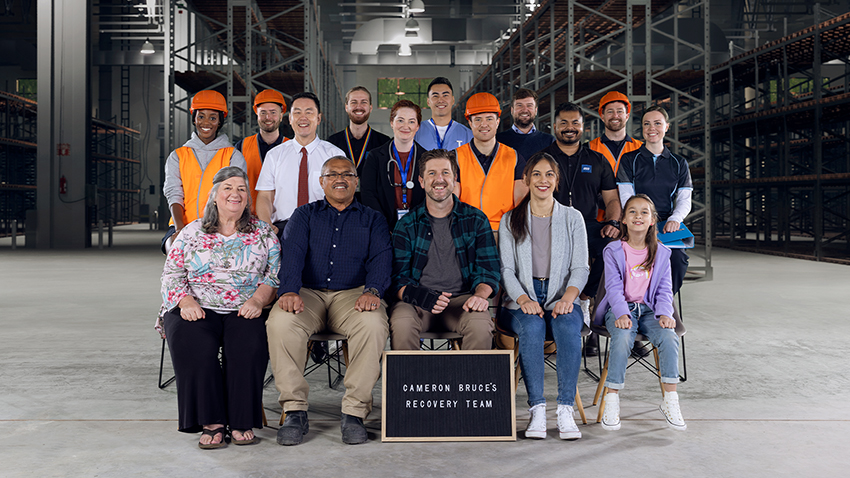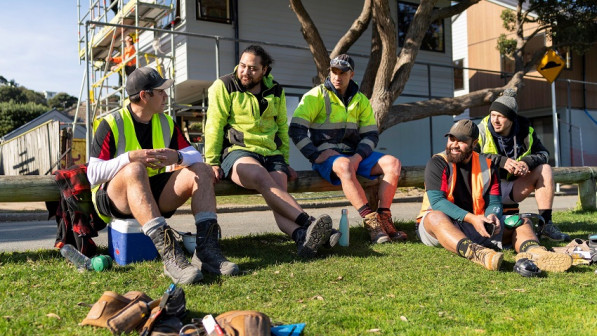E tautoko ana i te whakarauoratanga o tō kaimahi ki te wāhi mahiSupporting your injured employee to recover at work
The sooner an injured person gets connected to work, the better it is for their mental and physical recovery. They're more likely to return to their job, helping you and your team get back to business as usual.

What are the benefits of supporting your people to recover at work?
Get them back to work sooner
By playing an early and active role in their recovery, you’ll be helping them recover better and get back to their job sooner.
Retain skills and knowledge
Supporting an injured employee to stay connected to the workplace means their expertise can stay within your business.
Maintain productivity
An employee performing suitable duties while recovering can help reduce the cost of lost productivity.
Everyone benefits
Your whole team will see the benefits of supporting an injured colleague back to work, boosting team morale and helping build a positive workplace culture.
Examples of recovery at work in practice
Fintan’s recovery at work
Video transcript for Fintan’s recovery at work
Visual
Words appear onscreen: ‘Fintan’s recovery at work.'
Words appear onscreen: ‘When Fintan had a knee injury, he had a team around him to support his recovery journey.'
Fintan stands on a golf course next to a mower.
Transcript
Fintan: “I am Fintan Cooper. I’m an apprentice greenkeeper at Paraparaumu Beach Golf Club. I’m recovering from an ACL injury in 2021.”
Visual
Images of a football match. A player dribbles the ball. They grab their knee and hold it while rocking on the ground.
Transcript
Fintan: “I was playing in a football match and suddenly my knee gave way. I felt this sharp pop in my knee.”
Visual
Fintan in a shed putting on his work boots.
Words appear onscreen: ‘Following an MRI and advice from a specialist, Fintan took some time off. He then began his recovery at work.'
Leo Barber, General Manager at Paraparaumu Beach Golf Club, being interviewed.
Transcript
Leo: “When we initially heard the news that Fintan was going to be out for a period of time, it’s kind of two sets of emotions there. One obviously is compassion for Fintan and making sure that he’s ok.
Visual
Fintan on a mower, cutting the grass on the golf course.
Transcript:
Leo: “But then the selfish kind of aspect kicks in, and we’re a small team and, you know we’re going to be one person down and what that is going to look like.”
Visual
Words appear onscreen: ‘It takes a team effort to support an injured person to recover at work.'
Fintan at the gym on the cycling machine.
Transcript
Fintan: “I went and saw the physio at the gym and he did a few tests on my knee and he assessed physically where I was at. And then the occupational therapist came in and sat down with myself, Harry, and Leo, and she got an idea what greenkeeping is about.”
Visual
Fintan carrying out tasks on the green at the golf course.
Transcript
Fintan: “Talked to her about what kind of jobs there would be potentially for me to do. It was just a matter of everyone being on the same page.”
Visual
Harry Middleton, Head Greenkeeper at Paraparaumu Beach Golf Club, being interviewed.
Transcript
Harry: “We worked out a plan to try and slowly build him up to full time hours and be useful for his knee and be useful for us.”
Visual
Words appear onscreen: ‘Work provides physical activity, social connection, and a sense of purpose, which all make a positive difference to recovery. ‘
Fintan and his workmates standing around a whiteboard writing notes. Images of Fintan on a mower.
Transcript
Josh: “The boys accommodated me really well and they put me on a mower and it was just cool to be back out on the course again.”
Visual
Harry being interviewed.
Transcript
Harry: “He brings a lot to the team, he likes to learn lots so he keeps us all on our toes.”
Visual
Landscape imagery of the Paraparaumu Beach Golf Club grounds.
Words appear onscreen: “With the support of the team, Fintan was able to return to work five weeks earlier than expected.”
Leo being interviewed.
Transcript
Leo: “Trust the process. Communicate with your staff. Communicate with ACC. Take the best advice that’s available and patiently work through things.”
Visual
Words appear onscreen: ‘1. The sooner people get connected to work after an injury, the more likely they are to return to their job. 2. Start the conversation early and talk to each other regularly. 3. Tailor work to the person’s needs – adjust duties, work environment, workload, or hours. 4. Teamwork makes recovery work. '
Words appear onscreen: ‘For more information and resources visit acc.co.nz/recoveryatwork.'
ACC logo.
Fintan Cooper, an apprentice greenkeeper at the Paraparaumu Beach Golf Club, suffered an ACL injury while playing football. With support from his team, Fintan returned to work five weeks earlier than expected.
Josh's recovery at work
Video transcript for Josh Staats’s recovery at work
Visual
Words appear onscreen: ‘Josh’s recovery at work.'
Words appear onscreen: ‘When Josh had a head injury, his employer played a key role in his recovery journey.'
Josh Staats at his work looking at the camera.
Transcript
Josh: “My name’s Josh, I’m a machine operator at McCain Timaru, and in March 2020 I had a head injury.”
Visual
Josh stands looking at the camera on the forecourt of his workplace. A forklift drives by behind him.
Transcript
Josh: “I slipped at work, hit the back of my head, got rushed to hospital and told me I had a concussion. I went to my GP and he got some tests done.”
Visual
Josh at his workplace taking items out of his locker.
Words appear onscreen: ‘After suffering many concussions while playing rugby, Josh was worried about having another head knock. He began his recovery at work.'
Transcript
Josh: “When it came to recovery with the team that I work with, they were awesome because with a head injury sometimes you feel like, they’re not going to want me back cos I’m not going to be able to do this anymore or I’m not going to be able to compete at that level at the moment. I’m very lucky to have a company that’s come to bat for me.”
Visual
Words appear onscreen: ‘It’s proven that recovering at work after an injury helps people get better, sooner.'
Bevan Godfrey, McCain Health and Safety Manager, being interviewed.
Transcript
Bevan: “We are a family-owned business and the staff are literally our number one asset.”
Visual
Images of Josh and Bevan looking at machinery together. Josh pulls a hose on a piece of machinery.
Transcript
Bevan: “The good thing about our return to work programme that McCain has is it’s very much focused on the wellbeing aspect, because it’s all well and good sitting at home and trying to recuperate, but quite often that can be detrimental especially with long-term injuries.”
Visual
Words appear onscreen: ‘The whole team has a role to play – the injured person, their employer and workmates, health providers, and whānau.'
Bevan being interviewed.
Transcript
Bevan: “Probably the other key thing is really just taking an interest in the individual. Quite often businesses will say that, yup we want to get you back into the workforce, quite often it’s probably cos they’re short on a shift... and don’t really focus on the needs of the individual.”
Visual
Images of Josh driving a forklift at work. He then sits with a workmate and has a drink.
Transcript
Josh: “The social side of it, it was so good getting back. They were just amazing with that side of things. It’s the environment you want from your leaders and your colleagues, like you couldn’t ask for better.”
Visual
Words appear onscreen: ‘1. The sooner people get connected to work after an injury, the more likely they are to return to their job. 2. Start the conversation early and talk to each other regularly. 3. Tailor work to the person’s needs – adjust duties, work environment, workload, or hours. 4. Teamwork makes recovery work. '
Words appear onscreen: ‘For more information and resources visit acc.co.nz/recoveryatwork.'
ACC logo.
Josh Staats, a machine operator at McCain Timaru, had a head injury and many concussions from playing rugby. His employer played a key role in his recovery journey and getting him connected to work.
